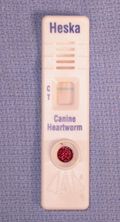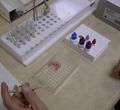 Heartworm Testing Considerations
Heartworm Testing Considerations
One explanation proposed for the increase in dogs diagnosed with heartworm is an increased sensitivity (or accuracy, if you will) in the tests that are being used. In other words, if you have a better test, you'll find more dogs with low numbers of heartworms that you might have missed previously.
Thirty years ago, we primarily tested for microfilariae (microscopic baby heartworms) in the blood. While I still perform the modified Knott's test (most sensitive for these) on many samples, we also perform antigen tests on all our samples. Many clinics perform only antigen tests.
 Antigen tests presently being used test for protein from the female reproductive tract and have the capability of detecting an infection with one female worm… sometimes. With fewer than four worms, many tests will miss 15% or more of infected dogs. “Exam Room” tests like the Heska Solostep CH or Idexx are definitely in this less sensitive category. The upside is that you only need three drops of blood — pretty helpful in tiny or uncooperative patients. I use quite a few of these test kits.
Antigen tests presently being used test for protein from the female reproductive tract and have the capability of detecting an infection with one female worm… sometimes. With fewer than four worms, many tests will miss 15% or more of infected dogs. “Exam Room” tests like the Heska Solostep CH or Idexx are definitely in this less sensitive category. The upside is that you only need three drops of blood — pretty helpful in tiny or uncooperative patients. I use quite a few of these test kits.
 The Dirochek Labkit by Synbiotics is the “gold standard” for sensitivity. It's a lot more complicated and time-consuming to run. We have been using this to batch test our (bigger) blood samples weekly (with the same technician doing the tests) for over nine years at Kennett Veterinary Clinic. Therefore, I do not believe this explanation can account for the increased number of heartworm infections we are diagnosing here. In fact, many of our "surprise" heartworm infections (dogs who have allegedly never missed a dose) are detected on the Heska test.
The Dirochek Labkit by Synbiotics is the “gold standard” for sensitivity. It's a lot more complicated and time-consuming to run. We have been using this to batch test our (bigger) blood samples weekly (with the same technician doing the tests) for over nine years at Kennett Veterinary Clinic. Therefore, I do not believe this explanation can account for the increased number of heartworm infections we are diagnosing here. In fact, many of our "surprise" heartworm infections (dogs who have allegedly never missed a dose) are detected on the Heska test.
We are also finding dogs that are positive for microfilariae while taking monthly preventive, something which never used to happen. The meds would give you a false negative test if you only checked for microfilariae.
It's pretty hard for me to buy "Better Testing" as the explanation, at least in our clinic.


Thanks for writing about the conference.